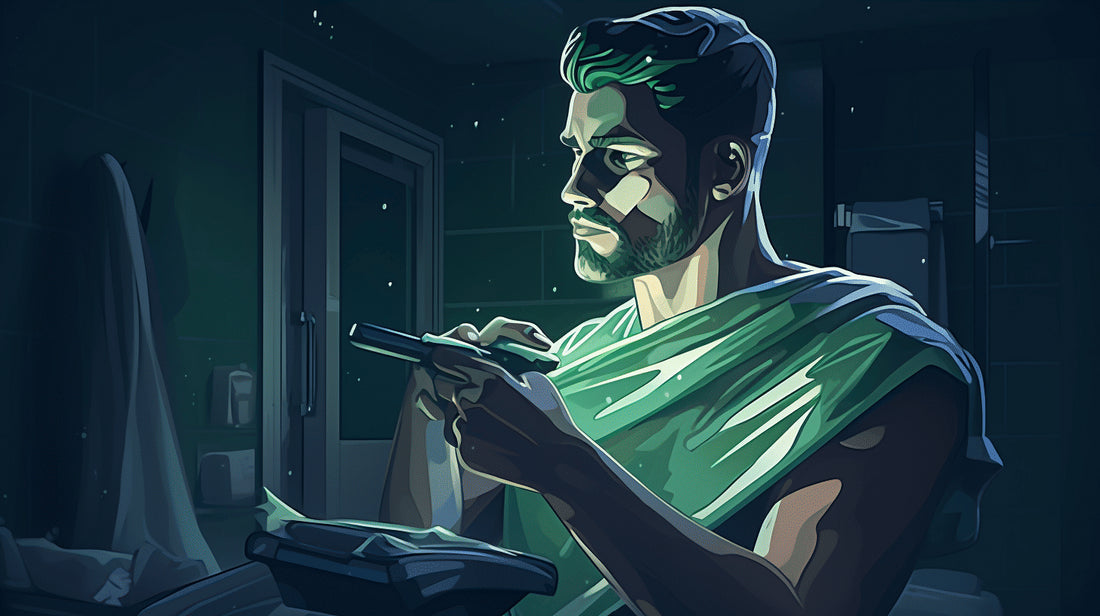Welcome to the world of smooth, rash-free skin! You've probably dealt with the annoying reddish rash that appears after a close shave, haven't you? If you're reading this, you're likely in search of a solution to this common yet irksome skin concern. Your search ends here. This article serves as a comprehensive guide, unlocking the secrets to fighting shaving rash - from reducing your shaving frequency to expert-approved treatments and handy at-home remedies. You'll find a wealth of information right at your fingertips to curb those pesky bumps and prevent future ones from taking residence on your skin. Dive in and let's start a journey to achieving that seamless post-shave skin you've always wanted.
The Secret to Reducing Shaving Frequency
For countless generations, daily shaving rituals have become commonplace due to societal norms and personal preferences. A smooth, freshly-shaven face might seem ideal, but it may surprise you to learn the benefits of giving your razor a break every now and then. Shaving every other day, rather than daily, can indeed improve the condition of one's skin, especially for those dealing with pseudo-folliculitis barbae.
Pseudo-folliculitis barbae, commonly known as razor bumps, is a condition that affects many people who shave regularly. The constant tugging and pulling of hairs can inflame the follicles, leading to a rash-like appearance and uncomfortable irritations. However, foregoing the blade for a day can alleviate this concern remarkably.
Here's why it works:
- Restoration: Giving the skin time to breathe and recover is essential for maintaining skin health. Shaving every other day allows the skin surface to restore its natural oils, which serve as a protective barrier.
- Preventing Irritation: Shaving less frequently reduces the incidents of friction, minimizing the chances of experiencing razor burn, redness, and general skin discomfort.
- Minimizing Ingrown Hairs: By shaving every other day, hairs are given a chance to break the surface of the skin, which reduces the incidence of painful and unsightly ingrown hairs.
The good news doesn't end there. Besides improving your skin's wellness, reducing your shaving frequency also cuts down on your grooming expenses. Less frequent use of razors and shaving products means they last longer, diminishing the need for constant replacements.
Here's an interesting quote by Andrew Goetz, co-founder of MALIN+GOETZ, that serves to support the merits of a reduced shaving frequency, "By shaving every other day, you give your skin the chance to recover and look its absolute best, while also avoiding unnecessary inflammation."
Reducing the frequency of your shaving regimen may seem like a minor change, but it can make a significant difference. It enables you to maintain healthier skin, save costs on grooming supplies, and, most importantly, enhance your well-being. Remember, every choice you make in your grooming routine contributes to the overall state of your complexion, so choose wisely.
Efficient Treatment for Razor Bumps
Razor bumps can be one annoying side effect of shaving. Not only do they compromise your smooth, fresh-faced look, but they can also be quite painful and uncomfortable. They're caused by hair that has been cut and then begins to grow back, curling into the skin rather than rising up from it. This can lead to inflammation, redness and the unsightly bumps that we all detest.
But don't despair just yet! There are several efficient treatments for razor bumps and we're about to explore them in detail.
Use of Salicylic Acid
Salicylic acid is a popular component in many skincare products. Its main magic spell? It's a beta hydroxy acid that deeply exfoliates, helping to remove dead skin cells, clear pores and reduce inflammation – a perfect solution for razor bumps. Incorporate a salicylic acid-based aftershave or lotion into your routine, and say goodbye to those troublesome bumps.
Glycolic Acid
Glycolic acid works similar to salicylic acid, but being an alpha hydroxy acid, it focuses on the surface of your skin. It gently dissolves the 'glue' that holds dead skin cells together, allowing newer and fresher skin cells to surface. The best part about this tiny warrior is that it's suitable for all skin types. A glycolic acid-infused aftershave or moisturizer can aid significantly in keeping razor bumps at bay.
Face Scrubs
Exfoliating with a face scrub not only gives your skin a healthy glow, but also prevents ingrown hairs— the primary cause of razor bumps. It sloughs off dead skin cells, allowing your razor to glide smoothly across the skin and ensuring that the hair grows back outwards, not into the skin. Aim to incorporate this step in your skincare routine about two to three times a week for the best results.
Topical Corticosteroids
For more severe cases of razor bumps, a dermatologist might recommend a topical corticosteroid. These offer potent anti-inflammatory properties and can help to quickly reduce the swelling and redness associated with razor bumps. However, these should only be used under medical supervision due to potential side effects.
Remember, consistency is key in skincare. Just as Rome wasn't built in a day, your razor bumps won't disappear overnight. Stick to the treatments, keep your skin clean and exfoliated, and gradually, you'll see those bumps recede into the shadows. After all, your skin deserves all the love and care you can provide!
Home Remedies for Shaving Rash
A shaving rash can be an unsightly and uncomfortable consequence of hair removal. This common dilemma can cause irritation, redness, and bumps, enough to make anyone dread the shaving process. Fortunately, home remedies can provide effective and speedy relief. From aloe vera gel to cold compresses, say goodbye to razor bumps and hello to smoother skin.
Aloe Vera Gel
One of the most natural and beneficial remedies for shaving rash lies in the aloe vera plant. Packed with soothing properties and delightful freshness, aloe vera gel can alleviate razor burn almost instantaneously. Known primarily for its anti-inflammatory and healing traits, the gel directly from this plant can reduce redness and irritation, while accelerating the healing process of any small nicks and cuts.
Witch Hazel
Witch Hazel is another natural remedy capable of calming an inflamed shaving rash. As an astringent, it can tighten skin tissues, reduce swelling, and indeed lessen redness. It's almost like your skin's guardian angel, providing a soothing chill while working to reduce infection risks.
Exfoliating
Contrary to popular belief, the remedy for a shaving rash can sometimes start before the shave. Exfoliating before shaving can prevent razor bumps by effectively removing dead skin cells. This technique unclogs the pores and allows for a cleaner, smoother shave, reducing the chances of post-shaving irritation dramatically.
Moisturizing Lotion or Oil
While it might seem contrary to dry, itchy skin caused by a rash, a moisturizing lotion or oil might just be what your skin craves. By adding necessary hydration, good quality moisturizers can help your skin recover faster, while also providing a protective layer against potential irritants.
Cold Compresses
When the itchiness and discomfort seem too much to handle, cold compresses could be your saving grace. By reducing itching and inflammation associated with shaving rash, these compresses work to soothe and numb your skin, offering almost instant relief.
In the pantheon of skincare, these home remedies have demonstrated effective, natural ways to combat shaving rash. Believe it in the power of botanicals with aloe vera and witch hazel, put faith in exfoliation, trust in moisturization, and embrace the cool comfort of cold compresses. Managing shaving rash has never been so simple.
Preventive Measures Against Shaving Rash
Experiencing a shaving rash can be extremely uncomfortable, not to mention that it is counter-intuitive to the smooth, clear skin we all chase after. Don't worry though. With these preventive measures under your belt, you can bid adieu to red, irritated skin, and welcome healthy, glowing skin even post-shaving.
Customize Your Razor
One of the first lines of defense against shaving rash is finding the perfect razor for your skin. A razor specifically designed for sensitive skin can make a world of a difference, so do your research. The sharper the blade, the less the chances of irritation, and remember- repurposing dull razors is not an act of resourcefulness, instead it's a direct invitation to razor bumps.
Choose The Right Direction of Shaving
To shave or not to shave against the grain- that is the question! Following the direction of your own hair growth when shaving can help minimize sketchy skin situations. Going against the grain might give a closer shave, but it also raises the risk of nicks, cuts and subsequently, irritation.
Shaving Gel or Cream
Just as a razor isn't one-size-fits-all, your pick of shaving gel or cream shouldn't be arbitrary either. Explore products that are best for your skin type and the specific area you're shaving. Also, resist the urge to pick or pluck at ingrown hairs. It may be oddly satisfying, but it's a no-no for preventing razor bumps.
Hygiene and Skincare
Lastly, copious amounts of tender loving care can significantly improve your shaving experience. Keep your skin clean and well-exfoliated to provide a smooth surface for your razor. Don't forget to replace your razor regularly as well, because a sharp new razor is another crucial preventive measure against razor rash.
Post-shaving, apply soothing products like witch hazel to provide relief for any burns or skin irritation. Topical antibacterial products and consistent skincare can also safeguard against the dreaded breakout from razor bumps. A little self-care can go a long way towards a smoother shave and happier skin.
With these preventive measures against shaving rash, you're sure to reduce the occurrence of this unpleasant side effect of hair removal. Start implementing these healthy shaving techniques now to reap their beneficial effects on your skin. Remember, your skin deserves the best, so don't skimp on providing it with the care it needs!
Conclusion
Adopting a combination of these shaving tips, from reducing shaving frequency to adopting efficient treatments for razor bumps, will go a long way in combating shaving rash. Incorporating home remedies like Aloe Vera gel, Witch Hazel, exfoliating, moisturizing lotions or oils, and even simple cold compresses into your daily routine can deliver the soothing relief you need. Not to mention, prevention is better than cure - so, going the extra mile to customize your razor, choose the right direction of shaving, pick suitable gels or creams, and uphold impeccable hygiene and skincare can make all the difference.
Remember, the journey to a rash-free face isn't about drastic changes but consistent, small tips and tricks applied regularly. And for that extra preventative measure or post-shaving soothing touch, you can always rely on the handmade, quality products of Bart's Balm that are loved worldwide. Whether its aftershave balms or pre-shave balm, you're just a click away from a smooth and scent-filled shaving routine. Visit the Bart's Balm website here to see the range of products they offer.
Frequently Asked Questions
-
What causes shaving rash?
Shaving rash is primarily caused by irritation and inflammation of the skin due to friction from shaving, sensitivity to shaving products, dull razors, or improper shaving techniques.
-
How can I prevent shaving rash?
To prevent shaving rash, ensure your razor is sharp and clean, use a moisturizing shaving cream or gel, shave in the direction of hair growth, exfoliate regularly, and moisturize your skin after shaving.
-
What are some home remedies for treating shaving rash?
Some home remedies for treating shaving rash include applying aloe vera gel, using a cold compress to reduce inflammation, applying a mixture of honey and yogurt, or using chamomile tea bags as a soothing compress.
-
Is there any specific shaving technique to avoid shaving rash?
Yes, to avoid shaving rash, use short and light strokes, avoid applying too much pressure, shave in the direction of hair growth, and rinse your razor frequently to remove hair and shaving cream build-up.
-
When should I see a dermatologist for shaving rash?
If the shaving rash persists despite home remedies, becomes infected, or is accompanied by severe pain, swelling, or pus-filled blisters, it is recommended to see a dermatologist for proper diagnosis and treatment.






